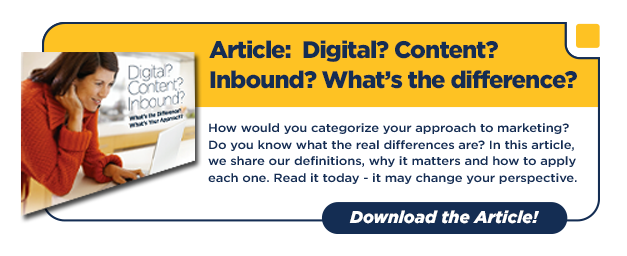 While the term “content marketing” is still relatively new, the concept really isn’t. Since the beginning, marketers have been responsible for developing content. Whether it was a proposal or an ad or even a cookbook, marketers create content.
While the term “content marketing” is still relatively new, the concept really isn’t. Since the beginning, marketers have been responsible for developing content. Whether it was a proposal or an ad or even a cookbook, marketers create content.
One of the biggest components of creating content is writing. It is also one of the most challenging (and sometime intimidating) roles marketing has today. We write web copy, emails, case studies, ebooks, whitepapers, video scripts, podcast questions…the list goes on and on.
And as all inbound marketers know, the purpose of all of this content is to convert visitors to leads which requires yet another writing skill set…writing to convert.
All of the content we create is worthless if no one downloads it. Don’t get me wrong…having the skill set to write that content is vitally important to inbound marketing. But if you can’t write copy that spurs visitors to action, your results will not meet your expectations.
Writing to convert requires a different mindset and approach. Here are five tips to help you turn your visitors into leads.
1. Know your audience…and then write for them
This tip applies across the board. Before you can write anything, you need to understand your audience. Define and document your buyer personas. Identify the challenges they are facing and questions they have. Understand the language they use.
Using that knowledge, write as though you’re talking directly to them. Use industry terms that mean something to them. Address their questions the way they ask them. For example, if your target audience includes CEOs of financial institutions, the language you use will be different than if your target audience includes maintenance supervisors on a manufacturing floor.
Your prospects need and want to feel like you understand them and the problems they have. “Speak” to them in a way that demonstrates that you do and they will be more likely to trust you enough to download your content.
2. Spend time on your headlines...significant time
Perhaps the most important part of any content is the headline. Many times, visitors decide based on titles alone whether or not they will continue reading. If they don’t continue reading, there is no chance to convert.
I recently read about a company that creates 25 headlines for every piece of content they create. This helps them identify the best converting option. While that may not be practical for a small marketing team with a lot on their plates, there are a few guidelines you can use when writing your titles.
Many copywriters, including Neil Patel from QuickSprout, use the four U’s formula when writing headlines.
1. Unique. Your prospects and customers are unique. They have a unique set of problems and they want to know that you’re not the same as the five other vendors who have contacted them this month.
Create headlines that don’t sound like all of the others and use language that will appeal to your target audience. For example, we try not to sugar coat things and to be very direct. Earlier this year, Doug wrote a post called 5 Examples of the Worst Outbound Marketing I’ve Seen…and What to do Instead.
Our subscribers loved it because it was different. It got their attention and they read it. Everyone writes about the best examples, best practices, best whatever. We gave them the worst and it got their attention.
2. Ultra-specific. Tell your audience exactly what they are going to get. If you’re giving them tips to do something better – tell them that. Titles are not the time to be super creative and clever. Be direct and specific.
If your post includes a video…tell them by indicating it in the title by adding video in square brackets. For example:

3. Urgency. It’s not always possible to convey urgency but when you can, it gets people to read your content. Using phrases like “don’t forget,” “losing XXX,” “time is running out” or “don’t get left behind,” make people feel like they need to do something.
4. Useful. If you’ve defined your buyer personas then you know what things are useful to audience. Make sure your titles convey that usefulness. Identify the benefit they will receive by clicking or reading that content.
For example, last year Doug wrote a post called 5 Tactics to Dramatically Increase Your Win Rate. Not only does that title convey usefulness, it is also unique, ultra-specific and even adds a little big of urgency.
While it is difficult to incorporate all four into every headline, accomplishing two or more will help you improve conversion.
3. Be succinct
When writing copy to convert, it is important to be direct and clear. Steer clear from using extra words or anything that is redundant. My husband is in the plumbing business. It drives him crazy when people say “hot water heater.” It’s redundant. If you already have hot water, why would you need a heater?
Also, don’t use more words than you need to convey an idea. Instead use short words and short sentences. Keep it simple.
Other ways to be succinct include using bullets and headers to break up text.
It’s easy to fall into these traps when you’re writing. Take the time to review every sentence you write and convey the main point in as few words as possible.
4. Use action words
While using action words seems like a tip for many kinds of writing, it is even more important when writing to convert. Taking action is what you want them to do.
When I’m talking to my kids, for example, and I want them to do something right now, I say, “Take out the garbage right now.” I don’t say, “The garbage can be taken out.”
Same goes for writing to convert on your website or anywhere else. If you want your visitors to download something, say “Download Ebook Now.” Don’t say, “The ebook can be downloaded here now.”
5. Test everything
Using these tips should certainly help you write better converting copy but the only way to know for sure what works with your audience is to test. Test headlines, test CTAs, test entire pages.
Most marketing automation platforms allow you to run A/B tests. Take advantage of that capability. Design your A/B tests to evaluate very specific items. Make sure you run them for long enough to gather meaningful data. When the test is finished, make the appropriate adjustments but never stop testing.
Writing copy that converts can be challenging but also fun. It’s a chance for copywriters to really put their skills to use and make a direct impact on results. Incorporate these tips into your approach. If you have more ideas or tips, add them to the comments below.

